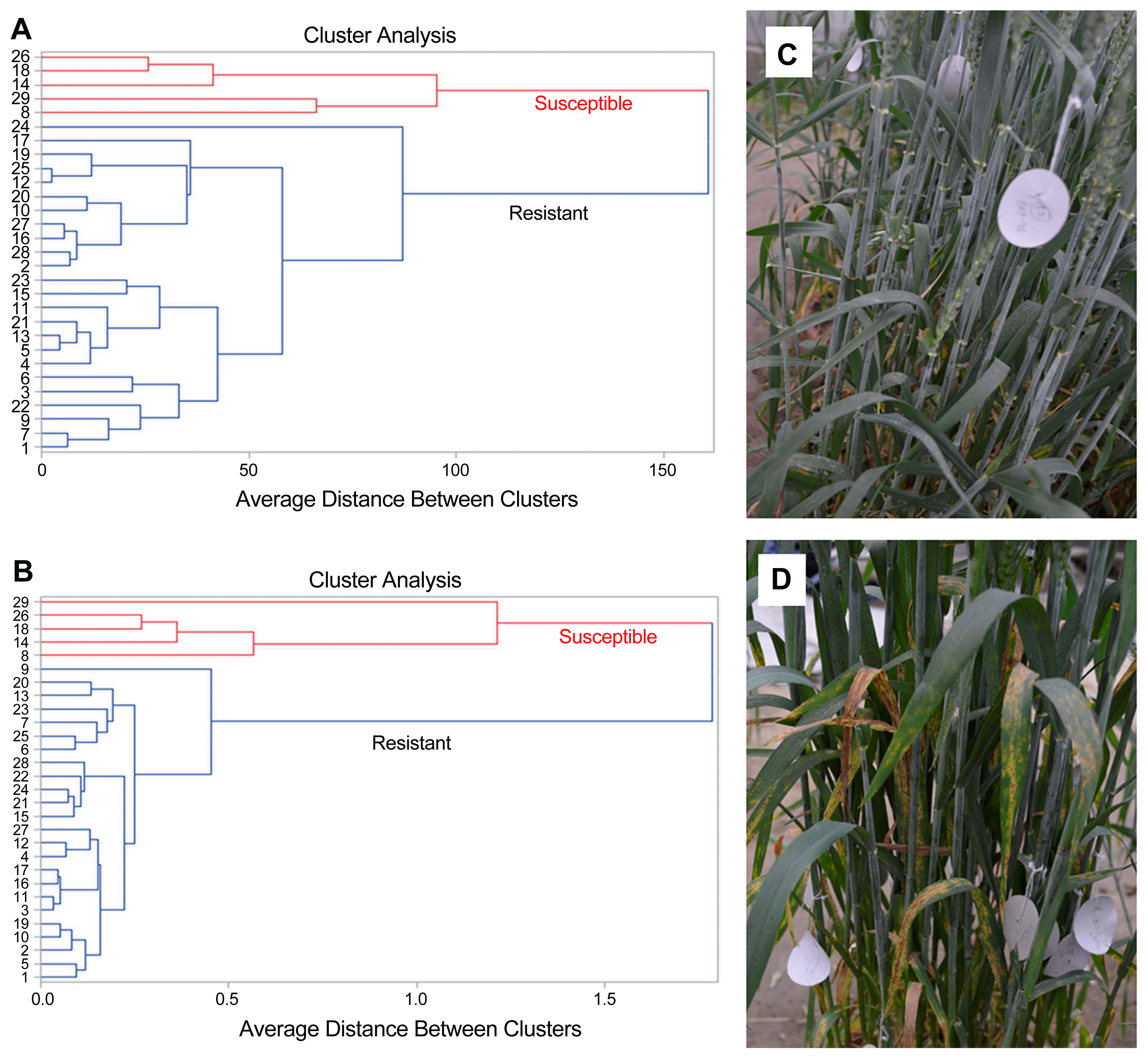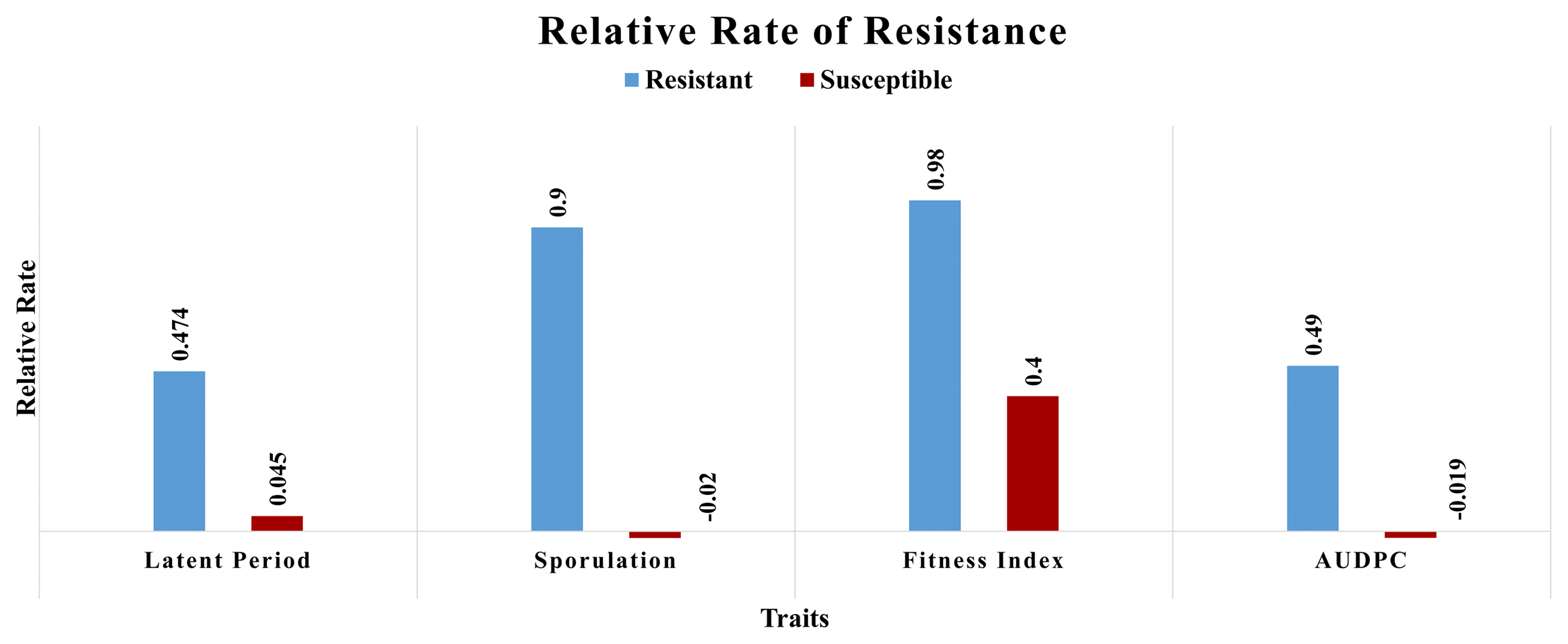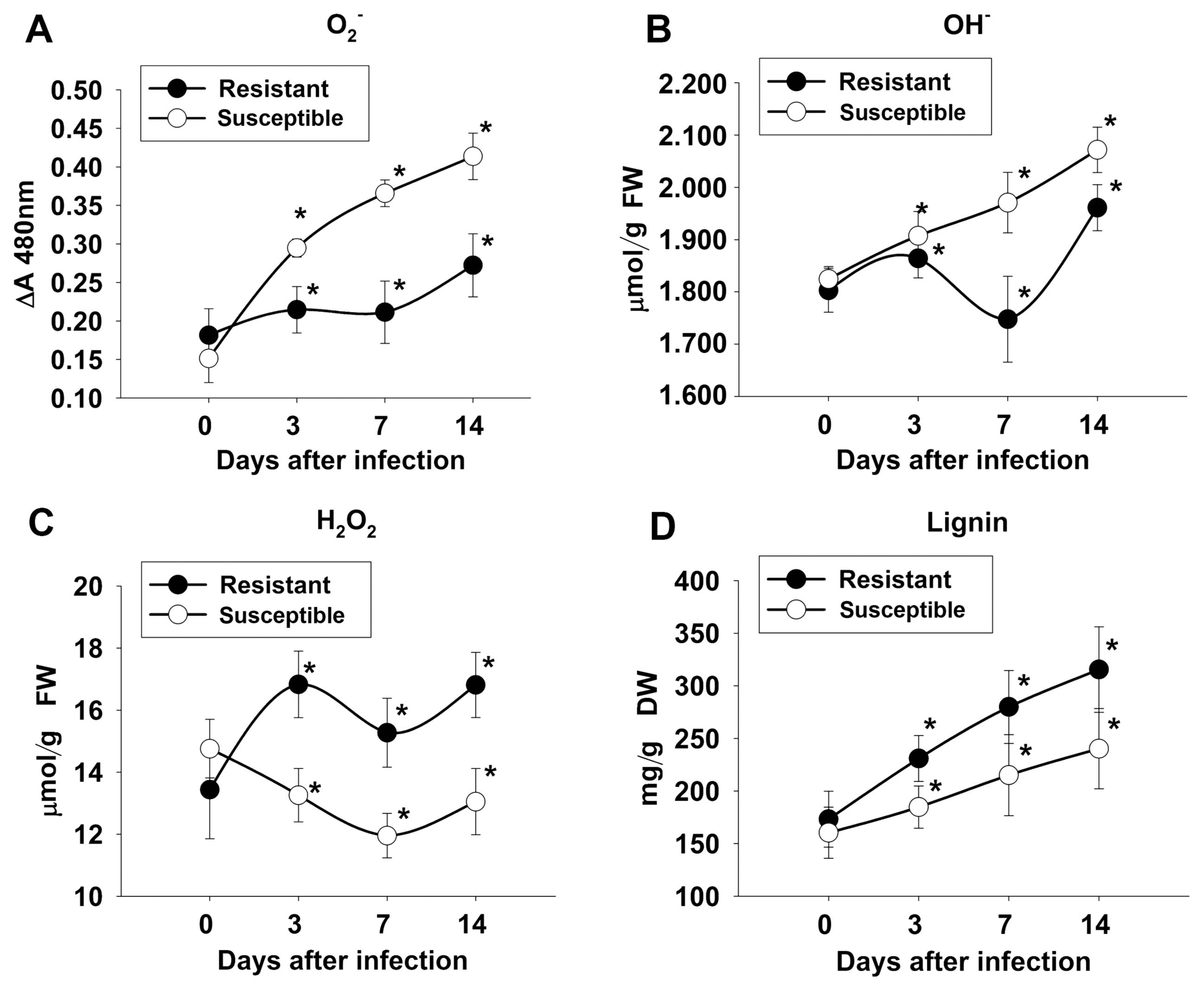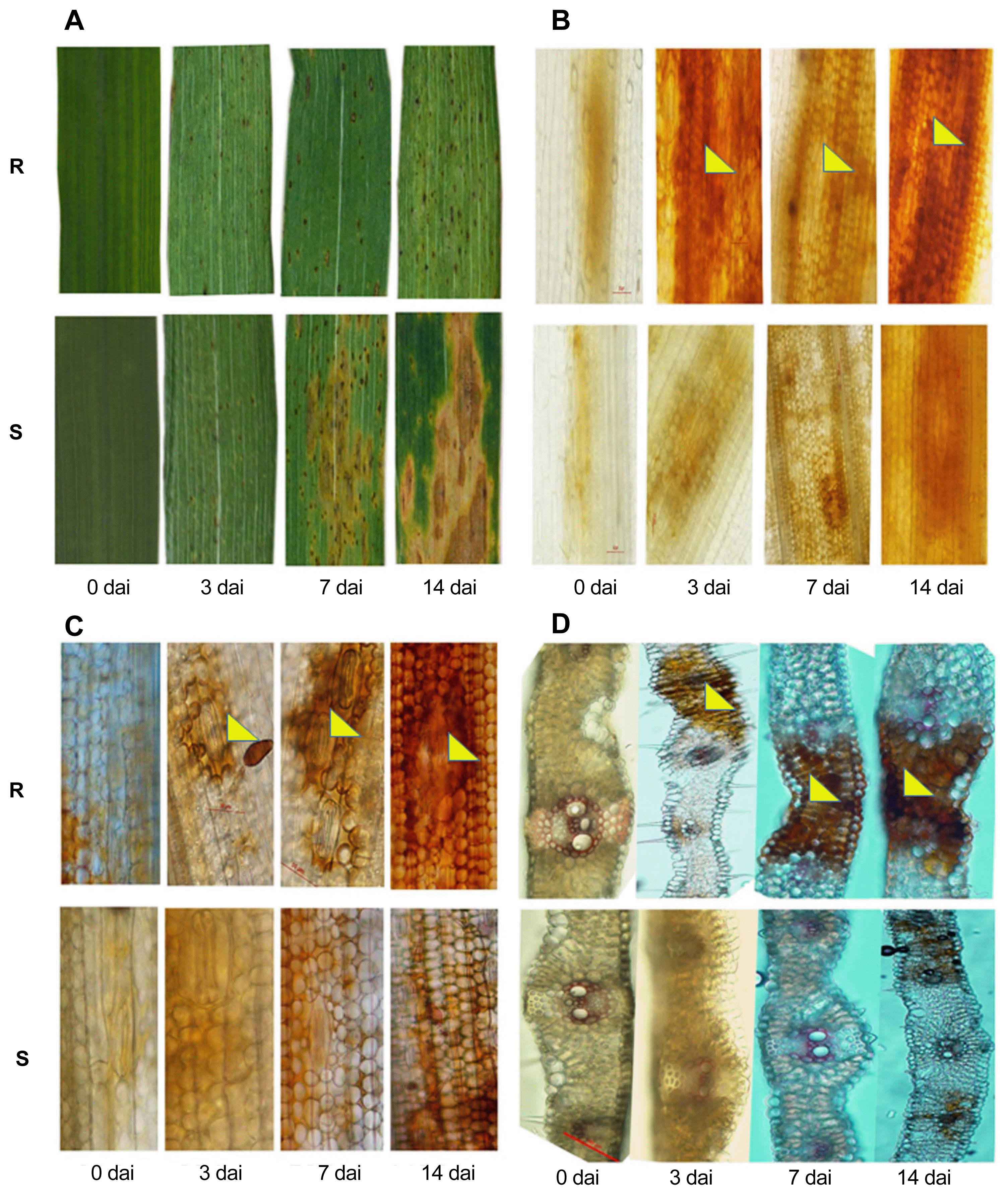Apel, K and Hirt, H 2004. Reactive oxygen species: metabolism, oxidative stress, and signal transduction.
Annu Rev Plant Biol. 55:373-399.


Bashyal, BM, Chand, R, Prasad, LC and Joshi, AK 2011. Partial resistance components for the management of spot blotch pathogen
Bipolaris sorokiniana of barley (
Hordeum vulgare L.).
Acta Phytopathol Entomol Hung. 46:49-57.

Beardmore, J, Ride, JP and Granger, JW 1983. Cellular lignification as a factor in the hypersensitive resistance of wheat to stem rust.
Physiol Plant Pathol. 22:209-220.

Bhuiyan, NH, Selvaraj, G, Wei, Y and King, J 2009. Role of lignification in plant defense.
Plant Signal Behav. 4:158-159.



Bingham, IJ, Walters, DR, Foulkes, MJ and Paveley, ND 2009. Crop traits and the tolerance of wheat and barley to foliar disease.
Ann Appl Biol. 154:159-173.

Bird, PM and Ride, J 1981. The resistance of wheat to Septoria nodorum: fungal development in relation to host lignification.
Physiol Plant Pathol. 19:289-299.

Bishop, DL, Chatterton, NJ, Harrison, PA and Hatfield, RD 2002. Changes in carbohydrate coordinated partitioning and cell wall remodeling with stress-induced pathogenesis in wheat sheaths.
Physiol Mol Plant Pathol. 61:53-63.

Boerjan, W, Ralph, J and Baucher, M 2003. Lignin biosynthesis.
Annu Rev Plant Biol. 54:519-546.


Boudet, AM 2000. Lignins and lignification: selected issues.
Plant Physiol Biochem. 38:81-96.

Ca├▒o-Delgado, A, Penfield, S, Smith, C, Catley, M and Bevan, M 2003. Reduced cellulose synthesis invokes lignification and defense responses in Arabidopsis thaliana.
Plant J. 34:351-362.


Chand, R, Yadav, OP, Bashyal, BM, Prasad, LC and Joshi, AK 2013. Technique for the maintenance of heterokaryotic isolates of B sorokiniana. Indian Phytopathol. 66:61-65.
Das, MK, Rajaram, S, Kronstad, WE, Mundt, CC and Singh, RP 1993. Associations and genetics of three components of slow rusting in leaf rust of wheat.
Euphytica. 68:99-109.

Denness, L, McKenna, JF, Segonzac, C, Wormit, A, Madhou, P, Bennett, M, Mansfield, J, Zipfel, C and Hamann, T 2011. Cell wall damage-induced lignin biosynthesis is regulated by a reactive oxygen species-and jasmonic acid-dependent process in Arabidopsis.
Plant Physiol. 156:1364-1374.



Dixon, RA, Chen, F, Guo, D and Parvathi, K 2001. The biosynthesis of monolignols: A ŌĆ£metabolic gridŌĆØ, or independent pathways to guaiacyl and syringyl units?
Phytochemistry. 57:1069-1084.


Dubin, HJ and van Ginkel, M 1991. The status of wheat diseases and disease research in warmer areas. In: Wheat for the nontraditional warm areas: A proceedings of the International Conference, eds. by DA Saunders, 125-145. International Maize and Wheat Improvement Center, Mexico City, Mexico.
Eisa, M, Chand, R and Joshi, AK 2013. Biochemical and histochemical traits: a promising way to screen resistance against spot blotch
Bipolaris sorokiniana of wheat.
Eur J Plant Pathol. 137:805-820.

Elad, Y and Evensen, K 1995. Physiological aspects of resistance to
Botrytis cinerea.
Phytopathology. 85:637-643.

Gupta, PK, Chand, R, Vasistha, NK, Pandey, SP, Kumar, U, Mishra, VK and Joshi, AK 2018. Spot blotch disease of wheat: the current status of research on genetics and breeding.
Plant Pathol. 67:508-531.

Gurung, S, Mahto, BN, Gyawali, S and Adhikari, TB 2013. Phenotypic and molecular diversity of
Cochliobolus sativus populations from wheat.
Plant Dis. 97:62-73.


Hakmaoui, A, P├®rez-Bueno, ML, Garc├Ła-Fontana, B, Camejo, D, Jim├®nez, A, Sevilla, F and Bar├│n, M 2012. Analysis of the antioxidant response of
Nicotiana benthamiana to infection with two strains of Pepper mild mottle virus.
J Exp Bot. 63:5487-5496.



Halliwell, B, Gutteridge, JM and Aruoma, OI 1987. The deoxyribose method: a simple ŌĆ£test-tubeŌĆØ assay for determination of rate constants for reactions of hydroxyl radicals.
Anal Biochem. 165:215-219.


Jacobo-Vel├Īzquez, DA, Gonz├Īlez-Ag├╝ero, M and Cisneros-Zevallos, L 2015. Cross-talk between signaling pathways: the link between plant secondary metabolite production and wounding stress response.
Sci Rep. 5:8608



Joshi, AK and Chand, R 2002. Variation and inheritance of leaf angle, and its association with spot blotch Bipolaris sorokiniana severity in wheat Triticum aestivum. Euphytica. 124:283-291.
Joshi, AK, Chand, R and Arun, B 2002. Relationship of plant height and days to maturity with resistance to spot blotch in wheat. Euphytica. 123:221-228.
Joshi, AK, Kumar, S, Chand, R and Ortiz-Ferrara, G 2004. Inheritance of resistance to spot blotch caused by
Bipolaris sorokiniana in spring wheat.
Plant Breed. 123:213-219.

Kumar, J, Sch├żfer, P, H├╝ckelhoven, R, Langen, G, Baltruschat, H, Stein, E, Nagarajan, S and Kogel, K-H 2002.
Bipolaris sorokiniana, a cereal pathogen of global concern: cytological and molecular approaches towards better control.
Mol Plant Pathol. 3:185-195.


Levene, H 1960. Robust tests for equality of variances. In: Contributions to probability and statistics, eds. by I Olkin, 278-292. Stanford University Press, Palo Alto, CA, USA.
Lightfoot, DJ, McGrann, GR and Able, AJ 2017. The role of a cytosolic superoxide dismutase in barley-pathogen interactions.
Mol Plant Pathol. 18:323-335.


Marschall, R and Tudzynski, P 2016. Reactive oxygen species in development and infection processes.
Semin Cell Dev Biol. 57:138-146.


Mehta, YR 1998. Constraints on the integrated management of spot blotch of wheat. In: Helminthosporium blights of wheat: Spot blotch and tan spot, eds. by E Duveiller, HJ Dubin, J Reeves and A McNab, 18-27. International Maize and Wheat Improvement Center, Mexico City, Mexico.
Mellersh, DG, Foulds, IV, Higgins, VJ and Heath, MC 2002. H
2O
2 plays different roles in determining penetration failure in three diverse plant-fungal interactions.
Plant J. 29:257-268.


Miedes, E, Vanholme, R, Boerjan, W and Molina, A 2014. The role of the secondary cell wall in plant resistance to pathogens.
Front Plant Sci. 5:358



Milus, EA and Line, RF 1980. Characterization of resistance to leaf rust in Pacific Northwest wheats.
Phytopathology. 70:167-172.

Misra, HP and Fridovich, I 1972. The role of superoxide anion in the autoxidation of epinephrine and a simple assay for superoxide dismutase.
J Biol Chem. 247:3170-3175.


Nicholson, RL and Hammerschmidt, R 1992. Phenolic compounds and their role in disease resistance.
Annu Rev Phytopathol. 30:369-389.

Parlevliet, JE 1979. Components of resistance that reduce the rate of epidemic development.
Annu Rev Phytopathol. 17:203-222.

Patterson, BD, MacRae, EA and Ferguson, IB 1984. Estimation of hydrogen peroxide in plant extracts using titanium IV.
Anal Biochem. 139:487-492.


Purwar, S, Gupta, SM and Kumar, A 2012. Enzymes of phenylpropanoid metabolism involved in strengthening the structural barrier for providing genotype and stage-dependent resistance to Karnal bunt in wheat.
Am J Plant Sci. 3:261-267.


Ros Barcel├│, A 2005. Xylem parenchyma cells deliver the H
2O
2 necessary for lignification in differentiating xylem vessels.
Planta. 220:747-756.


Sch├żfer, P, H├╝ckelhoven, R and Kogel, KH 2004. The white barley mutant albostrians shows a super-susceptible but symptomless interaction phenotype with the hemibiotrophic fungus
Bipolaris sorokiniana.
Mol Plant-Microbe Interact. 17:366-373.


Shaner, G and Finney, RE 1977. The effect of nitrogen fertilization on the expression of slow-mildewing in Knox wheat. Phytopathology. 67:1051-1056.
Shapiro, SS and Wilk, MB 1965. An analysis of variance test for normality (complete samples).
Biometrika. 52:591-611.

Sharma, S, Sahu, R, Navathe, S, Mishra, VK, Chand, R, Singh, PK, Joshi, AK and Pandey, S 2018. Natural variation in elicitation of defense-signaling associates to field resistance against the spot blotch disease in bread wheat (
Triticum aestivum L.).
Front Plant Sci. 9:636



Shetty, NP, Mehrabi, R, L├╝tken, H, Haldrup, A, Kema, GH, Collinge, DB and J├Ėrgensen, HJ 2007. Role of hydrogen peroxide during the interaction between the hemibiotrophic fungal pathogen
Septoria tritici and wheat.
New Phytol. 174:637-647.


Sillero, JC and Rubiales, D 2002. Histological characterization of resistance to
Uromyces viciae-fabae in faba bean.
Phytopathology. 92:294-299.


Singh, PK, Zhang, Y, He, X, Singh, RP, Chand, R, Mishra, VK, Malaker, PK, Reza, MA, Rahman, MM, Islam, R, Chowdhury, AK, Bhattacharya, PM, Kalappanavar, IK, Crossa, J and Joshi, AK 2015. Development and characterization of the 4th CSISA-spot blotch nursery of bread wheat.
Eur J Plant Pathol. 143:595-605.

Southerton, SG and Deverall, BJ 1990. Histochemical and chemical evidence for lignin accumulation during the expression of resistance to leaf rust fungi in wheat.
Physiol Mol Plant Pathol. 36:483-494.

Thordal-Christensen, H, Zhang, Z, Wei, Y and Collinge, DB 1997. Subcellular localization of H
2O
2 in plants. H
2O
2 accumulation in papillae and hypersensitive response during the barley-powdery mildew interaction.
Plant J. 11:1187-1194.

Tomerlin, JR, Eversmeyer, MG, Kramer, CL and Browder, LE 1983. Temperature and host effects on latent and infectious periods and urediniospore production of
Puccinia recondita f. sp. tritici.
Phytopathology. 73:414-419.

Tronchet, M, Balagu├®, C, Kroj, T, Jouanin, L and Roby, D 2010. Cinnamyl alcohol dehydrogenases-C and D, key enzymes in lignin biosynthesis, play an essential role in disease resistance in Arabidopsis.
Mol Plant Pathol. 11:83-92.


Willocquet, L, Savary, S and Yuen, J 2017. Multiscale phenotyping and decision strategies in breeding for resistance.
Trends Plant Sci. 22:420-432.


Wu, G, Shortt, BJ, Lawrence, EB, Leon, J, Fitzsimmons, KC, Levine, EB, Raskin, I and Shah, DM 1997. Activation of host defense mechanisms by elevated production of H
2O
2 in transgenic plants.
Plant Physiol. 115:427-435.



Yusuf, CS, Chand, R, Mishra, VK and Joshi, AK 2016. The association between leaf malondialdehyde and lignin content and resistance to spot blotch in wheat.
J Phytopathol. 164:896-903.

Zadoks, JC, Chang, TT and Konzak, CF 1974. A decimal code for the growth stages of cereals.
Weed Res. 14:415-421.









 PDF Links
PDF Links PubReader
PubReader Full text via DOI
Full text via DOI Full text via PMC
Full text via PMC Download Citation
Download Citation Print
Print






